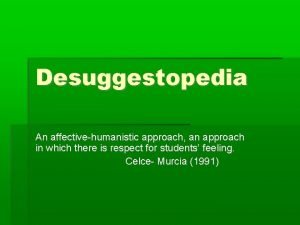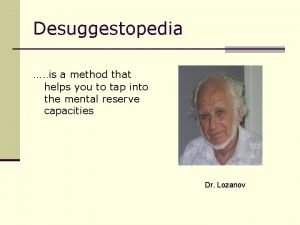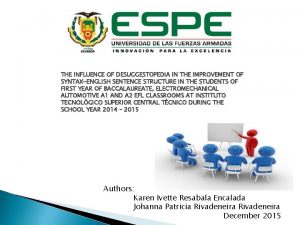Techniques and Principles in Language Teaching VI Desuggestopedia













- Slides: 13

Techniques and Principles in Language Teaching VI. Desuggestopedia Josephine Hsin-Chou Huang Department of Applied English St. John’s University

A. B. C. D. First concert Second concert Primary Activation The students play-fully re-read the target language dialog out loud as individuals or in groups. Create adaptation

Positive suggestion Direct: Appeal to the students consciousness Indirect Appeal to the students subconscious (more powerful)

I. Introduction A. An approach in which there is respect for students' feelings B. We need to "desuggest" the limitations of our capacity

I. Introduction C. There are two planes in communications 1. The conscious plan: the linguistic message is encoded through the attention of the learners on the language 2. The subconscious plane: The factors which influence the linguistic message (the tension of leaning) is relieved through music, which suggests that learning is easy and pleasant.

II. Principles A. Goals: 1. Help students to lean to use a foreign language for everyday communication 2. Desuggest the psychological barriers when learning

II. Principles B. The role of the teacher: 1. The authority in the classroom 2. Trusted by students and provide the secure feeling for students

II. Principles C. Characteristics 1. Classroom (Classroom set-up 7 Bright and cheerful with poster displaying grammatical information 2. Texts Handouts cont 3 ning lengthy dialogs and translations

II. Principles 3. Presenting dialogs during 2 concerts a. The 1 st concert (Active concert): Read the dialog with the rhythm and pitch of the music b. The 2 nd concert (Passive concert): The teacher read the dialog at a normal speed c. Primary activation: The students playfully reread the target language dialog out

II. Principles 4. Homework: Read the dialog before going to sleep and getting up in the morning 5. Activities (Creative adaptation) Dramatizations, games, songs, and question-and-answer exercises 6. Role play: Create their own lines of dialogs relevant to the situation,

II. Principles 7. Positive suggestion a. Direct suggestion: Appeal to the students' consciousness b. Indirect suggestion: Appeal to the students' subconscious (more powerful)

II. Principles D. The feelings of the students: They are taken serious consideration in this method, 1. Students are relaxed and confident 2. Psychological barriers are desuggested 3. Indirect positive suggestions are made to enhance students' self-confidence E. Language skills: Speaking F. Areas of language: vocabulary

II. Principles G. The role of the students' native language: 1. It is used in translation 2. When necessary 3. It is used less and less in the later stages of learning H. Evaluation: On students' normal in-class performance. Test is considered a threat to the relaxed atmosphere. I. Error: Gently correct it
 Desuggestopedia principles
Desuggestopedia principles Desuggestopedia method activities
Desuggestopedia method activities The principles of interactive language teaching
The principles of interactive language teaching Principles of interactive language teaching
Principles of interactive language teaching Micro teaching is a scaled down encounter
Micro teaching is a scaled down encounter Suggestopedia characteristics
Suggestopedia characteristics Disadvantages of suggestopedia
Disadvantages of suggestopedia Guiding principles for teaching and learning in mtb-mle pdf
Guiding principles for teaching and learning in mtb-mle pdf Teaching approach
Teaching approach Desuggestopedia method ppt
Desuggestopedia method ppt Desuggested
Desuggested Map drawing in direct method
Map drawing in direct method Fundamental teaching techniques of lsvt big
Fundamental teaching techniques of lsvt big Techniques of teaching history
Techniques of teaching history




















